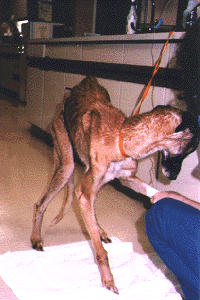 |
Many thanks and congratulations to Mireille for her dedication in rescuing these martyred greyhounds from the hands of their torturers. |
| Spanish Greyhounds "Galgos" are in fact dogs used by Galgueros (Spanish hunters) during championships. The dogs run in pairs in pursuit of a hare and are followed by two judges on horseback who determine whether the Greyhounds are "clean" or "dirty" depending on how they follow the game. Dogs said to be "dirty" because they have followed the shortest trajectory, which is in fact a proof of intelligence for us, are severely punished on the spot, as their owner's "honor" must be washed clean! | |
|
But the greatest horror is yet to come, either their owner keeps them or they are sold on the spot but to suffer abuses that are beyond comprehension. If they're not hanged, with their front legs touching the ground to prolong the agony, they're beaten to death, burned alive, euthanized with injections of herbicide or bleach, poisoned or used as bait in dog fights or shark fishing. Others are thrown down a well in agony, their limbs broken, or left wounded in the wild. Still others are marooned in cellars and stables with no light, no water and no food. They wait in indifference for a slow, agonizing death. Given no names and no affection, these dogs have never had the chance to be carefree puppies. Numerous associations have spoken out against this barbarism. One of them is the Greyhounds in Nood association in Ghent: the first in Belgium, and one of the first in Europe, under the presidency of Mireille Broeders, who has devoted herself for years to saving as many dogs as possible from Spanish hell. Through her work, Mireille has already found homes for 1,000 of these poor greyhounds, who were once considered dumb animals and never pets. If you would like to adopt a Greyhound : Mireille makes the trip a few times a year, when she has enough adopters, so that when the dogs arrive in Belgium, they don't have to endure the added stress of passing through a shelter for more than 24 hours, and go straight to their foster families. Anyone who has taken in martyred dogs from Spain will tell you that these dogs adapt to their new lives with an astonishing ability to adapt, finding a new lease on life and discovering how to play, much to the delight of those who have opened their hearts and their homes to them. Greyhounds are intelligent, sensitive dogs of astonishing gentleness and infinite kindness, who finally deserve to have a happy dog's life. They're all handsome and proud-looking, these princes in rags, despite their wounds or their thinness. |
|






 English (United Kingdom)
English (United Kingdom)